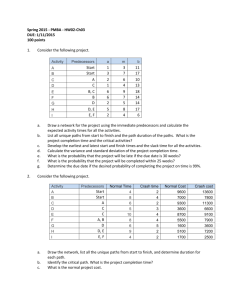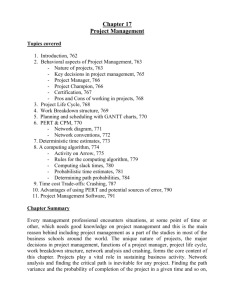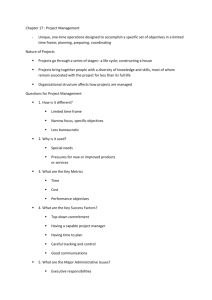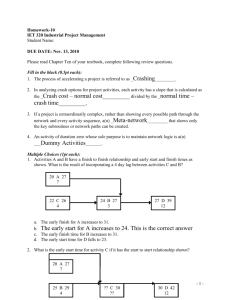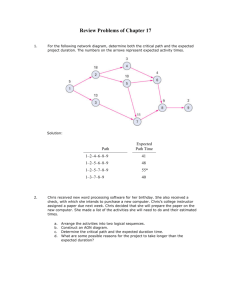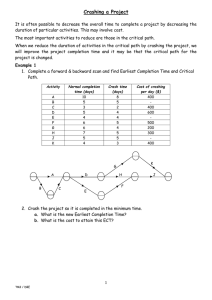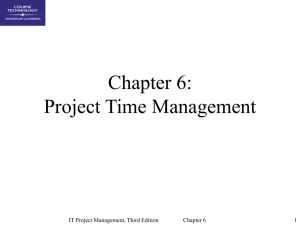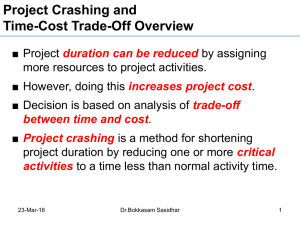Real-World Project Management
advertisement
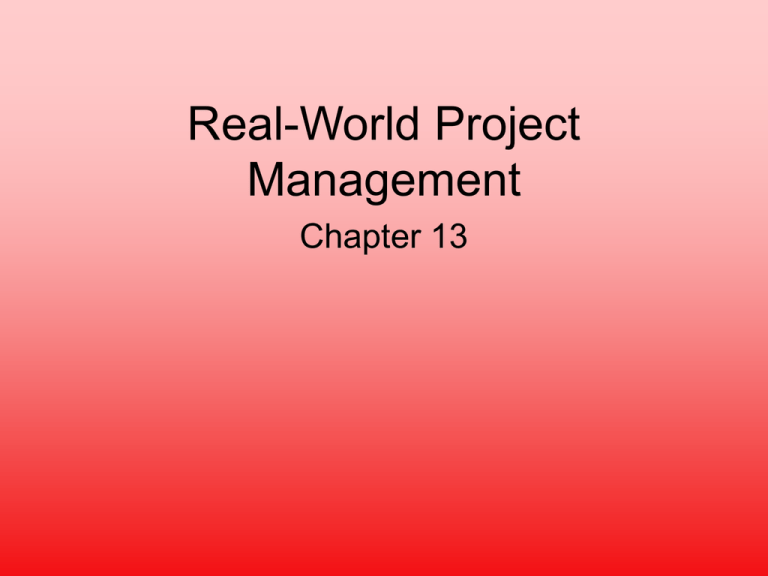
Real-World Project Management Chapter 13 Characteristics of Project Management • Unique one-time focus – Difficulties arise from originality • Subject to uncertainties – Unexplained or unplanned events often arise, affecting resources, objectives and timelines • Multiple stakeholders – Different interests in both the processes and outcomes of the project • No clear authority – Project chain of command may conflict with the formal structures of the participating organizational units Chapter 13 - Real World Project Management 1 Measuring Project Success • Stakeholders determine the degree of success for each project undertaken – For example, success may be measured by savings in operating costs or revenue generated – Complications arise when different groups of stakeholders have different interests, values and objectives – Stakeholders must be identified, prioritized and their measures of success well understood • Process must be developed to achieve the desired results Chapter 13 - Real World Project Management 2 Qualitative Methods for Achieving Success • The path to success lies in conservative planning – Establishes the opportunity to exceed expectations – Stakeholder expectations must be managed • Expectations must be controlled and managed over time • Project managers must possess both technical and soft skills • Work objectives must be clearly defined in order to decrease the possibility of scope creep Chapter 13 - Real World Project Management 3 Qualitative Tools and Techniques for Project Management • Network diagramming is one of the most versatile techniques for planning – Graphic illustration of the activities in a project and their relationship • Provides a timeline, critical path, activities on the critical path System Development Project Analysis Data Analysis Process Analysis Design Reports Design Development Database Design Code Data Entry Chapter 13 - Real World Project Management Code Database Testing and Implementation Code Reports System and Network Testing Installation and Training 4 Choosing a Project Network Diagramming Technique • To commonly accepted approaches are Activity on Node (AON) and Activity on Arrow (AOA) Using activity on node (AON), nodes represent activities and arrows show precedence. B A C 1 A B 3 2 C 4 Using activity on arrow (AOA), arrows are activities and nodes are “events.” Precedence is captured in event relationships. Chapter 13 - Real World Project Management 5 AOA 1 A AON B 2 Activity Relationships C 3 4 B A A precedes B, which precedes C. C (a) 1 (b) C 3 B 4 C 2 B 1 B A 2 3 A C 4 1 A B C 2 A B A C 5 B D D 2 1 4 C 3 3 4 B and C cannot begin until A has been completed. B (c) (d) A and B must be completed before C can be started. A A C 5 Dumm yD 6 A C B D (e) 1 A 2 B Dummy 5 A B C 3 (f) 4 D C D C and D cannot begin until both A and B have been completed. C cannot begin until both A and B have been completed; D cannot begin until C has been completed. B and C cannot begin until A has been completed; D cannot begin until both B and C have been completed. Diagramming the Systems Development Project A C E I Start Finish B D F H G Chapter 13 - Real World Project Management 7 Developing a Project Schedule • A project network can be used to develop a project schedule or plan • The duration of a project is equal to the longest path on the project network – This is the critical path – A project may contain more than one critical path • Activity slack is the amount of time a project can be delayed before it becomes critical Chapter 13 - Real World Project Management 8 Computing Earliest Start and Earliest Finish Times 0 A 4 4 C 9 9 E 13 16 I 17 4 5 4 1 Start Finish 0 B 3 3 D 8 8 F 11 13 H 16 3 5 3 3 Early Finish 8 G 12 Early Start 4 Chapter 13 - Real World Project Management Activity Duration 9 Computing Late Start and Late Finish Times 0 0 A 4 4 4 4 4 C 5 9 9 9 9 E 13 16 4 13 I 17 16 1 17 Start Finish 0 1 B 3 3 3 4 4 Late Start D 5 F 8 8 9 10 3 13 8 9 G 11 13 H 16 13 3 16 12 4 13 Chapter 13 - Real World Project Management Late Finish 10 Probabilistic Project Management • Treat activities as if they are common variables and assign probabilities to activity times to reflect the inherent uncertainties – Calculate an optimistic time (a),a most likely time (m) and a pessimistic time (b) – Probabilities for activity times are taken from the beta distribution – The formula for te is a weighted average of the three time estimates in which the most likely time (m) is weighted four times that of either the optimistic or pessimistic times Chapter 13 - Real World Project Management 11 Analyzing Probabilities • Assume that the duration of all activities are independent from each other • Activity times are random variables • Let T = due date for the project, TE = expected completion time for path • T, TE and 2 can be used to calculate a zscore – The value of z is the number of standard deviations that the project due date is from the expected completion time Chapter 13 - Real World Project Management 12 Making Time, Cost and Performance Trade-Offs • Project completion dates are generated in isolation of management expectations and may demonstrate no relationship to their desires • To meet stakeholder expectations, you may: – Add resources – Reduce performance specifications – Change management expectations – Combine the previous alternatives Chapter 13 - Real World Project Management 13 Making Time-Cost Trade-Offs • Adding resources may add complexity and increase project length • Accurate estimates regarding the times and costs involved are necessary – Normal time (NT) = Expected activity duration without crashing – Normal cost (NC) = Expected activity costs without crashing – Crash time (CT) = Expected activity duration with crashing – Crash cost (CC) = Expected activity cost with crashing Chapter 13 - Real World Project Management 14 Making Time-Cost Trade-Offs • Costs are linear, it costs proportionally the same to reduce an activity by one day as it does two days • Per period crashing cost is referred to as “bang for the buck” – Only crash activities that are on the critical path – Crashing an activity on the critical path may not reduce the project duration – The process of crashing may cause the set of critical paths to change • The crashing technique for managing projects reduces the duration by making a trade-off between time and money Chapter 13 - Real World Project Management 15 Reducing Performance Specifications and Other Alternatives • Project duration can be reduced by eliminating certain project deliverables – Allows managers to reallocate resources originally intended for other activities into new activities that could reduce the project duration without increasing costs • Elimination of activities depends on criticality of deliverable • The project due date may be negotiable • Individual alternatives are not mutually exclusive Chapter 13 - Real World Project Management 16
